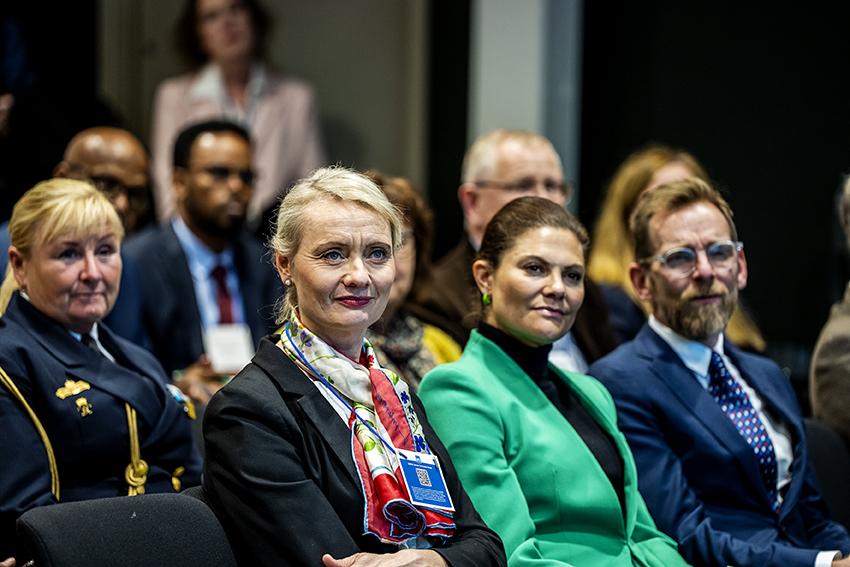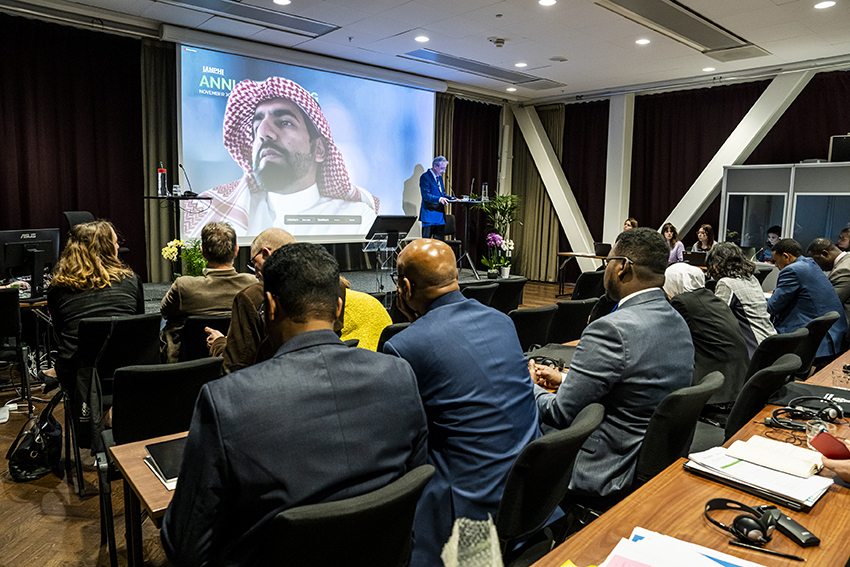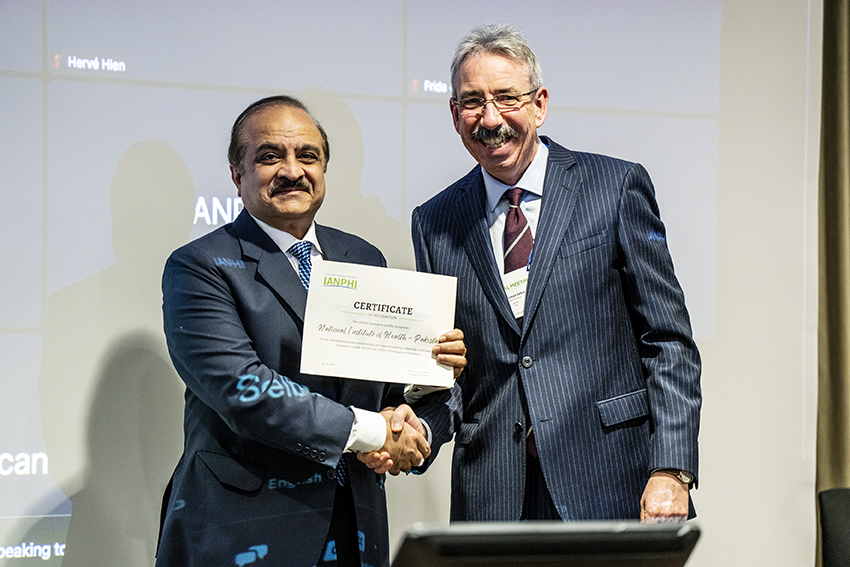Botswana, Greece, Jordan, Montenegro, and DRC Join IANPHI

2022 IANPHI General Assembly. From left to right: Dr. Karin Tegmark Wisell, director general, Public Health Agency of Sweden, Crown Princess Victoria of Sweden, Jakob Forssmed, Swedish Minister for Social Affairs and Public Health
Photo credit: Carolina Byrmo
IANPHI held its annual general assembly today, which opened the 2022 IANPHI Annual Meeting. Hosted by the Public Health Agency of Sweden in Stockholm, the three-day event brings together over 200 leaders from National Public Health Institutes from 75 countries.
IANPHI President Prof. Duncan Selbie led today’s assembly, which began with a keynote speech by the Swedish minister for Social Affairs and Public Health, Jakob Forssmed, in the presence of Crown Princess Victoria of Sweden.
“We are keenly aware that many public health challenges are global,” said Jakob Forssmed. “The theme of this conference – pandemic, conflicts and climate change – points to challenges that demand close international cooperation.” He emphasized the Swedish government’s commitment to contain antimicrobial resistance, “one of the most daunting health challenges of all times.” The minister also talked about the prevention and control of noncommunicable diseases (NCDs) and the “need to accelerate our response to NCDs”, stating that “globally, the burden of disease is immense”.
“There is an explosion of interest for National Public Health Institutes,” said Duncan Selbie. “The greatest strength we have is our peer-to-peer support – people on the ground working together, sharing experiences, helping each other.”
IANPHI Welcomes Five New Members
As IANPHI celebrates its 15th anniversary in 2022, Prof. Selbie emphasized the Association’s exceptional growth since its creation in 2006 by 39 founding member institutes. Today, IANPHI voted in five new members, bringing the member count to 115 institutes from 98 countries.
- Public Health Institute of Botswana
The Public Health Institute of Botswana was established in September 2020 as a state-owned institute. Its legal framework and operationalization are currently under development. The institute’s mission is to guide the provision of safe and comprehensive quality public health services and coordinate management of emergencies at the national level, in order to strengthen the public health system.
- National Public Health Organization of Greece
The National Public Health Organization (EODY) is the universal successor of the existing Center for Disease Control and Prevention, abolished in 2019. It is under the supervision of the Minister of Health. EODY is the operational center for planning and implementing actions to protect public health, with readiness to respond to emergency health risks, coordinating its functions with the needs of the country. EODY develops and promotes actions aimed at promoting health, preventing chronic diseases and generally reducing the burden of non-communicable diseases.
- Jordan Center for Disease Control
The Jordan Center for Disease Control (JCDC) is an autonomous body established through a royal directive in the wake of the COVID-19 pandemic. JCDC’s core functions are the evaluation and analysis of health status, public health surveillance with outbreak investigations, and the development of prevention programs and health promotion, as well as the evaluation and promotion of equitable access to health services. JCDC also has a capacity of regulation and enforcement in the health sector, and assures the quality of personal and population-based health services. It also takes part in public health research, acts for the reduction of impacts of emergencies and disasters on health and drives laboratory work.
- Institute of Public Health of Montenegro
The Institute of Public Health of Montenegro (IPHMNE) was created in 1922. It was originally known as the Permanent Bacteriological Station before undergoing several changes of name through the years, which were a reflection of the needs and major changes in the field of preventive medicine that required organized efforts to improve and preserve the health of the Montenegrin population. Today the institute is a highly specialized health institution.
- Democratic Republic of Congo National Institute of Public Health
The National Institute of Public Health (NPHI) of the Democratic Republic of Congo is a public entity under the authority of the Minister of Health. The purpose of the NPHI is to provide programs, civil society, and policy makers with information, expertise, and an effective response framework to ensure effective prevention, detection, and response to epidemics and other health emergencies.

General Assembly participants
Photo credit: Carolina Byrmo
Prominent Public Health Leaders Join the Executive Board
Two new Executive Board (EB) members were elected to the IANPHI EB, which provides policy oversight for the organization.
- Hongbing Shen: Prof. Shen has been the director general of the Chinese Center for Disease Control and Prevention since July 2022. He has also been serving as the deputy director of China’s National Administration of Disease Control and Prevention since 2021 and teaches epidemiology at Nanjing Medical University. Prof. Shen has been engaged in epidemiological research for over 30 years. His research interest focuses on cancer epidemiology, prevention and treatment strategies for high-risk populations, birth cohort, and health and medical big data sciences, and has made remarkable contributions to enhancing cancer prediction and precision prevention.
- Yanaris Lopez Almaguer: Dr. Almaguer has been the director general of the Pedro Kourí Institute of Tropical Medicine (IPK) of Cuba since 2021. She previously served as the national director of environmental health at the Ministry of Public Health.
Recognition of Success 2022
IANPHI’s Recognition of Success initiative highlights a selection of outstanding projects led by IANPHI member institutes. In 2022, 29 projects from 24 countries were submitted to IANPHI’s regional chairs who selected one significant project per region.
The winners by region:
- IANPHI Africa Regional Network: South Africa’s National Institute for Communicable Disease (NICD), for building a collaborative modelling consortium for COVID-19 in South Africa.
In March 2020, NICD was mandated to coordinate COVID-19 modelling activities for South Africa and established the South African COVID-19 Modelling Consortium (SACMC) comprising specialists from various background and sector of activities to identify and co-ordinate available modelling capacity. Since no single organization had sufficient modelling capacity to meet South Africa’s COVID-19 modelling needs, four core organizations, including NICD, collaborated to jointly develop transmission dynamic models and provide advanced analytical support. The SACMC's collaborative approach to modelling the COVID-19 pandemic in South Africa provided timely decision support to policy makers by optimising the available modelling and advanced analytical capacities to provide essential projections of future trends and severity.
- IANPHI Asia Regional Network: National Institute of Health, Pakistan for the establishment and operationalization of the National Command and Operations Center (NCOC) for COVID-19 emergency response.
As multisector coordination was much needed to respond to the pandemic, the Pakistani government established the NCOC in April 2020 using a “One Nation” approach with active representation of all the relevant stakeholders, provincial governments and district administrations. Thanks to its unique expertise, NIH played a major role in the NCOC and supported the emergency operations and response. The operational coordination mechanism provided technical support for routine operations in the COVID-19 response, including lab-testing capacity, contact tracing, field operations, lock down guidelines, disease management and treatment guidelines. After two successful years of operation, the NCOC was successfully institutionalized at NIH in March 2022. The project presented an innovative strategy to manage the pandemic that also allowed to strengthen the position of NPHIs as critical factors in the implementation of public health policies.

Dr. Aamer Ikram, director of Pakistan's National Institute of Health, and Prof. Duncan Selbie, president of IANPHI
Photo credit: Carolina Byrmo
- IANPHI Europe Regional Network: Sciensano, Belgium, for the establishment of a national wastewater-based epidemiological surveillance program
Belgium started to use wastewater-based epidemiology (WBE) to monitor the circulation of SARS-CoV-2 in its population. The wastewater results are shared with the public health authorities on a weekly basis and provide complementary information to conventional epidemiological indicators for epidemiological assessment. As a result of this project, an effective monitoring via wastewater of SARS-CoV-2 and its variants is now in place, and the foundations for a more structured wastewater-based epidemiological surveillance program have been put in place. The current WBE initiative is currently being extended towards other microbial parameters of public health importance, such as but not limited to Poliovirus and other non-polio enteroviruses, Hepatitis E, Klebsiella and antimicrobial resistance markers.
- IANPHI Latin America Regional Network: Instituto Nacional de Salud, El Salvador, for strengthening the capacity of the country’s National Integrated Health System staff to provide high-quality medical care
With the emergence of the COVID-19 pandemic in 2020, the Instituto Nacional de Salud (INS) started looking into possibilities to provide learning based on clinical cases to health professionals at local levels. A contract was signed with the U.S. University of New Mexico to obtain training support from the ECHO Uruguay Superhub to organize virtual sessions within teleclinics. Between January and August 2022, 6,690 health professionals participated in sessions, with an average of 103 attendees per teleclinic. The University of New Mexico, through the ECHO Institute, nominated the hub to become a Superhub and thus become knowledge node creators in El Salvador and the Latin American region. The project was completed with the opening of a National Simulation Centre in August 2021 equipped with state-of-the-art technology for medical education that recreates a hospital environment.